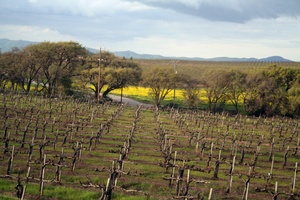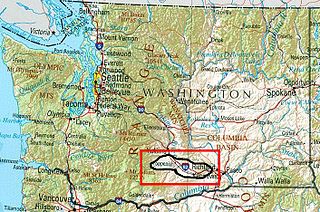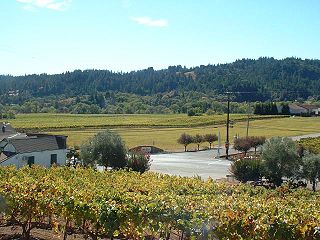Related Research Articles

Carmel Valley is an American Viticultural Area (AVA) located in Monterey County, California, southeast of Carmel-by-the-Sea and it is one of the ten AVAs in the county. Approximately 100 miles (161 km) south of San Francisco, the AVA was recognized by the Bureau of Alcohol, Tobacco and Firearms (ATF), Treasury on January 13, 1983 after reviewing the petition submitted by Mr. David Armanasco, General Manager of Durney Vineyard, located in Carmel, to propose a viticultural area named “Carmel Valley.”

The Livermore Valley AVA is an American Viticultural Area in Alameda County, California, surrounding the city of Livermore in the Tri-Valley region. It is named after the Livermore Valley, which is named, along with the city, after Robert Livermore, a landowner whose holdings encompassed the valley.
Ramona Valley AVA is an American Viticultural Area in San Diego County, California, centered on the community of Ramona. It was designated the 162nd American Viticultural Area in January, 2006 by the Alcohol and Tobacco Tax and Trade Bureau of the Department of the Treasury, which recognized the area for its distinctive microclimate, elevation, and soil attributes.

Willamette Valley is an American Viticultural Area (AVA) which lies in the Willamette Valley of Oregon. The AVA is the wine growing region which encompasses the drainage basin of the Willamette River. It stretches from the Columbia River in the north to just south of Eugene in the south, where the Willamette Valley ends; and from the Oregon Coast Range in the west to the Cascade Mountains in the east. At 5,360 square miles, it is the largest AVA in the state, and contains most of the state's wineries; approximately 908 as of 2021.

The Umpqua Valley AVA is one of the first American Viticultural Area (AVA) in Oregon and located entirely within Douglas County, Oregon. It became a sub-appellation within the larger Southern Oregon AVA when it was established in 2004. Its boundaries are detailed in Code of Federal Regulations, Title 27 Chapter I Part 9 section 89(C).

Yakima Valley is the first American Viticultural Area (AVA) established within Washington state, gaining the recognition on May 4, 1983. Within the vast Columbia Valley AVA, Yakima Valley appellation cultivates more than 53,000 acres (21,448 ha) giving the region the largest concentration of wineries and vineyards in the state. The most widely planted varietals in the area are Chardonnay, Riesling, Merlot, Cabernet Sauvignon, Pinot gris, and Syrah. Nearly 40% of Washington's annual wine production is made from Yakima Valley grapes. In addition to grapes, the Yakima Valley is also home to several fruit orchards growing apples, cherries, nectarines, peaches, pears and plums. Around the town of Zillah, there is the Zillah Fruit Loop driving tour through the area's orchards and vineyards. The area is also home to nearly 80% of the US hop production. In July 2024, the Yakima Valley was named best wine region in the U.S. by readers of USA Today.

Red Mountain is an American Viticultural Area (AVA) that encompasses the local region surrounding Red Mountain in Benton County, Washington. The viticultural area was formally recognized on June 11, 2001 by the Bureau of Alcohol, Tobacco and Firearms (ATF), Treasury after reviewing the petition submitted by Lorne Jacobson of Hedges Cellars to establish an area known as "Red Mountain." It lies entirely within the Yakima Valley and vast Columbia Valley appellations and is a small AVA in the state at only 4,040 acres (6.31 sq mi) in area and lies between Benton City and the City of West Richland. The area has more than 2,225 acres (900 ha) under cultivation of primarily red varietals including Cabernet Sauvignon, Merlot, Sangiovese, Cabernet Franc and Syrah. The reputation of the area's wines has brought Red Mountain worldwide attention and acclaim for producing some of the most desired Washington State vintage wines.

Walla Walla Valley is an American Viticultural Area (AVA) located within Washington state and extending partly into the northeastern corner of Oregon. The wine region is entirely included within the larger Columbia Valley AVA. In addition to grapes, the area produces sweet onions, wheat and strawberries After the Yakima Valley AVA, the Walla Walla AVA has the second highest concentration of vineyards and wineries in Washington State. Walla Walla hosts about 140 wineries. The area was recognized on March 7, 1984 by the Bureau of Alcohol, Tobacco and Firearms (ATF), Treasury after reviewing the petition submitted by Mr. Richard L Small, President of the Walla Walla Valley Winegrowers Association, for the establishment of a viticultural area in southeast Washington and northeast Oregon, east of Lake Wallula, to be known as "Walls Walls Valley." At the time, Walla Walla Valley viticultural area was approximately 178,560 acres (279 sq mi) with two bonded wineries and about 60 acres (24 ha) from several vineyards.
San Pasqual Valley, historically spelled as San Pascual, is the northernmost community of San Diego, California. It is named for the Kumeyaay village of San Pasqual that was once located there. It is bordered on the north by the city of Escondido, on the east and west by unincorporated land within San Diego County, and on the south by the city of Poway and the community of Rancho Bernardo. San Pasqual Valley is home to the San Diego Zoo Safari Park.

Temecula Valley is an American Viticultural Area (AVA) in the Temecula Valley, located in southwestern Riverside County, California against the eastern slopes of the Santa Ana Mountains. It was initially established by the Bureau of Alcohol, Tobacco and Firearms (ATF), Treasury as "Temecula" on October 23, 1984 based on submitted petitions from by the Rancho Califomia/Temecula Winegrowers Association and Callaway Vineyard and Winery, Temecula, California in 1982. It was renamed "Temecula Valley" by the Alcohol and Tobacco Tax and Trade Bureau (TTB) in 2004, approving the 2001 petition by Temecula Valley Winegrowers Association. The petition stated the name change would provide a more accurate description of the Temecula geography and greater clarity as to its location for wine consumers and the public. The petition did not request any change to the established AVA boundaries. This was the first American Viticultural Area to change its name after the initial approval. Temecula Valley encompasses 33,000 acres (52 sq mi) and 5,000 acres (8 sq mi) is located in a "protected" area referred to as the Citrus/Vineyard Zone. This area is generally located in and around the Rancho California Road area with Riverside County. County guidelines strictly enforce the number of acres needed to build a winery, lodging and other limited housing and commercial ventures.

Sonoma County wine is wine made in Sonoma County, California, in the United States.
Arroyo Grande Valley is an American Viticultural Area (AVA) located in San Luis Obispo County, California approximately 12 miles (19 km) southeast of the county seat San Luis Obispo. Arroyo Grande Valley was recognized on February 5, 1990 by the Bureau of Alcohol, Tobacco, Firearms and Explosives (ATF) as the state's 60th AVA based on the petition filed in 1987 by Don Talley of Talley Vineyards and William S. Greenough of Saucelito Canyon Vineyard for the establishment of the "Arroyo Grande Valley" viticultural area in San Luis Obispo County. The 16 miles (26 km) long, approximately 67 square miles valley appellation benefits from its east-northeast orientation allowing the breeze from the Pacific Ocean to moderate the climate of the area. The valley is divided by a fog line produced by the cool maritime layer where Zinfandel, Petite Sirah and Rhône varietals are grown on the higher elevations near Lopez Lake and the cooler mid-valley vineyards being home to Chardonnay and Pinot noir. On April 8, 2022, the Alcohol and Tobacco Tax and Trade Bureau (TTB) approved the designation of the expansive San Luis Obispo (SLO) Coast AVA overlapping the boundaries of Edna Valley and Arroyo Grande Valley viticultural areas because they share common features. However, these two previously established areas still have unique characteristics to retain their viticultural area distinctions within SLO Coast. Edna Valley lies immediately to the northwest, the Los Padres National Forest straddles the north leg boundary, the Santa Maria Valley AVA lies to the southeast of Arroyo Grande Valley, and the Pacific Ocean communities of Oceano, Grover City and Arroyo Grande abut its southwestern border.
The Sonoma Coast AVA is an American Viticultural Area in Sonoma County, California, United States containing more than 500,000 acres (2,000 km2), mostly along the coastline of the Pacific Ocean. It extends from San Pablo Bay to the border with Mendocino County. The appellation is known for its cool climate and high rainfall relative to other parts of Sonoma County. The area has such a broad range of microclimates that petitions have been made to the United States Department of the Treasury Alcohol and Tobacco Tax and Trade Bureau for the creation of sub-AVAs such as the Fort Ross-Seaview AVA which was approved in December 2011.
Mount Veeder AVA is an American Viticultural Area located within Napa Valley AVA among the Mayacamas Mountains. The boundaries of this appellation include 25 sq mi (64.7 km2) with 1,000 acres (400 ha) planted on thin volcanic soil. Many vineyards are found on the steep mountain face some as steep as 30°. The steepness of the angle gives the vineyards benefits of more direct sunlight and better drainage.

The Stags Leap District AVA is an American Viticultural Area located within the Napa Valley AVA 6 miles (9.7 km) north of the city of Napa, California. The Stags Leap District was the first appellation to be designated an AVA based on the unique terroir characteristics of its soil. The soil of this region include loam and clay sediments from the Napa River and volcanic soil deposits left over from erosion of the Vaca Mountains. Like many Napa Valley AVAs, Stags Leap District is particularly known for its Cabernet Sauvignon. In 1976 at the Judgment of Paris wine tasting, the 1973 Stag's Leap Wine Cellars Cabernet from the area that would become this AVA won first place in the red wine category, beating out classified Bordeaux estates. Today, the Stags Leap District is home to twenty different wineries.
The Oak Knoll District of Napa Valley AVA is an American Viticultural Area located within Napa Valley AVA at the southern end of the valley floor. The appellation's close proximity to San Pablo Bay results in a climate that is cooler and more moderate than any region in Napa Valley other than the Los Carneros AVA. The AVA has more vines planted to it than any other wholly contained appellation within the Napa Valley. A wide variety of wine grapes do well in this climate, including varieties not widely grown in other parts of Napa Valley, such as Riesling and Pinot noir. The district is planted largely to Merlot, Chardonnay and Cabernet Sauvignon, in that order. Oak Knoll District Chardonnay has a reputation for a restrained, delicate style. The appellation was officially designated an appellation within the Napa Valley AVA on April 26, 2004.

The Texas High Plains AVA is an American Viticultural Area located on the Llano Estacado region of Texas. The appellation is the second largest American Viticultural Area in Texas, and covers an area of over 270,000 acres (422 sq mi). Most of the vineyards are on flat terrain at elevations between 3,000 feet (914 m) and 4,000 feet (1,219 m) above sea level. The Texas plains can be extremely dry, so most vineyards are irrigated with water from the Ogallala Aquifer. The hardiness zones are 7a and 7b.
The Escondido Valley AVA is an American Viticultural Area located in Pecos County, Texas. It was the fifth designated wine area in the state of Texas, and covers an area of over 32,000 acres (129 km2). There are no wineries located in the Escondido Valley AVA. The largest winery making Escondido Valley AVA designated wines was Ste. Genevieve Wines, whose winery facilities were located near Fort Stockton. Mesa Vineyards, owners of the Ste. Genevieve Winery, filed for bankruptcy in January 2022.

The Cucamonga Valley AVA is an American Viticultural Area in San Bernardino County, California. It is in the Cucamonga Valley region of the Pomona Valley, about 15 miles (24 km) west of San Bernardino.

Santa Barbara County wine is an appellation that designates wine made from grapes grown mostly in Santa Barbara County, California which is located approximately 50 miles (80 km) north of Los Angeles County. County names in the United States automatically qualify as legal appellations of origin for wine produced from grapes grown in that county and do not require registration with the Alcohol and Tobacco Tax and Trade Bureau (TTB) of the Treasury Department. TTB was created in January 2003, when the Bureau of Alcohol, Tobacco and Firearms, or ATF, was extensively reorganized under the provisions of the Homeland Security Act of 2002.
References
- ↑ "§ 9.25 San Pasqual Valley" (Title 27: Alcohol, Tobacco and Firearms; Part 9 — American Viticultural Areas; Subpart C — Approved American Viticultural Areas). Code of Federal Regulations. Retrieved January 23, 2008.
- ↑ "American Viticultural Areas by State". Wine Institute. 2008. Archived from the original on January 27, 2008.
- 1 2 "San Pasqual Valley (AVA): Appellation Profile". Appellation America. 2007. Archived from the original on May 16, 2008. Retrieved January 23, 2008.
- ↑ "San Pasqual Valley". Vivino. Retrieved 2023-05-31.
- ↑ "Orfila Winery and Vineyards". Archived from the original on March 10, 2010.
- ↑ "Ferrara Winery".
- ↑ "Cordiano Winery".